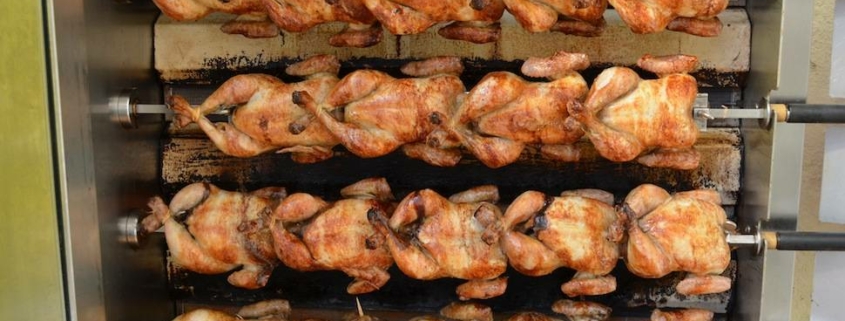ANÁLISIS POLLO ASADOR ANTE UN VERANO MARCADO POR EL COVID-19
Establecimientos de proximidad y delivery (entrega a domicilio) como vías para llegar a las familias españolas con un producto saludable con eminente carácter social.
Desde la Asociación Interprofesional de la Avicultura de Carne de Pollo / Propollo, que reúne a más del 95% del sector avícola en España, se analiza cómo el pollo asador, producto típico español, muy vinculado a la estacionalidad del verano y la afluencia de turistas internacionales, se ha adaptado a la “nueva normalidad”.
Portavoz: Jordi Montfort, Secretario General de Propollo.
Contexto del sector avícola y pollo asador
- Antes del COVID-19, cada mes se producían en España en torno a 46 millones de pollos, donde la estacionalidad marcaba el tipo de producto que se demandaba en el mercado.
- Durante los meses de verano, el canal HORECA, al que se deriva habitualmente el 25% de la producción durante el resto del año, redistribuye los productos dirigidos a colectividades y restaurantes (compuesto sobre todo por piezas en canal, filetes y alitas), al conocido como pollo asador, propio de bares, restaurantes con terrazas, puestos en fiestas patronales, o establecimientos con comida para llevar, así como playa. Aunque también aumenta la demanda en canal distribución en costa.
- La demanda derivada del turismo en zonas de costa, donde también se notaba la llegada de turistas extranjeros, propiciaba que esta cifra subiera. En total cada verano llegaban a España 52.8 millones de turistas, con un consumo medio de 500 gr de pollo, lo que hace un total de 26,4 millones de Kgs.
- Cerca de 35 millones de pollos (el mencionado 25% de la producción) se destinaban durante los 3 meses de verano al canal HORECA (más de 49 millones de Kg).
Cómo ha afectado el COVID-19
- Tras decretarse en marzo las primeras medidas de confinamiento y el cierre total del canal HORECA, así como la paralización absoluta del turismo internacional y nacional, los productores vieron como ese 25% de producción orientado a este canal desaparecía por completo, aunque una parte importante ya estaba planificada para los meses de abril, mayo y junio.
- Los productores (granjas e integradoras) apenas han tenido oportunidad de adaptar su producción a la demanda real, pues necesitan al menos 3 meses para realizarlo por los ciclos de crianza de los pollos.
- Por lo tanto, una parte del producto ya estaba en las granjas, y parte de esta producción ha tenido que conservarse en frío (congelado), aunque no ha habido apoyo por parte de la Administración para este concepto, a diferencia de otros productos como ovino, caprino, bovino o cerdo.
Pollo Asador: tipología de producto & distribución sector
- El pollo asador se corresponde con un ejemplar de 1,4 Kg aproximadamente. Para llegar al mercado, este pollo pasa una media de 36 días en las granjas.
- El precio de venta en establecimientos además es un factor muy importante para la adquisición del mismo por parte de los consumidores. Suele estar entre 8€ y 12€, dependiendo de la zona geográfica y tipo de preparación.
- Algunas de las distribuidoras especializadas en el propio canal HORECA han tenido que adaptar su producción a otro tipo de productos, pero esto se ha realizado ya para los meses de julio-agosto-septiembre.
- Las noticias de desconfinamiento y posible recuperación del turismo interior, apenas han permitido margen de maniobra a los productores para adecuar la crianza del pollo asador.
- Las cifras más optimistas, sujetas a los recientes brotes y nuevas medidas de confinamiento, hablan de una demanda en torno a 7 millones de ejemplares (un 20% de los 35 millones habituales).
- Pero es una cifra que fluctúa y está sujeta además a las nuevas noticias en torno a la cancelación del turismo internacional, especialmente el británico en las costas.
- Y también por las importaciones de pollo procedentes de los excedentes de países como Italia o Polonia, además de los habituales de Brasil. Se estima que un 15% del consumo de pollo en el canal HORECA proviene de importaciones.
La restauración y hostelería española se adapta a nuevos hábitos
- Algunos de nuestros asociados, sobre todo integradoras, ya optaron por participar en años anteriores en proyectos de restauración con venta directa, lo que facilitaba además contar con establecimientos de venta de comida preparada por todo el país.
- Esta actividad se suma a la de distribución de pollo asador para cadenas de restauración, pequeño comercio, bares, establecimientos en playa, hipermercados con venta de platos de comida preparada, etc.
- Todos estos establecimientos han visto como un factor importante en la nueva normalidad han sido las opciones de Delivery (entrega a domicilio), así como la propuesta de comida para recoger en tienda bajo pedido, incluida la petición a veces vía telefónica y otras online.
- Tanto cadenas de restauración como establecimientos individuales optan por este tipo de servicio como forma de facilitar el acceso a una comida preparada vinculada a consumo familiar o de ocio en el hogar.
- Hemos detectado que esta opción además está vinculada no sólo en sitios de costa, sino también en grandes ciudades como Madrid, Barcelona o Sevilla. La opción de delivery permite a los consumidores contar con una alimentación sana en su hogar, así como impulsar el negocio de pequeños comercios de barrio.
- Para algunos establecimientos en ciudades de interior, este tipo de estrategias de ventas y cercanía a clientes locales ha facilitado que el descenso de las ventas haya podido ser menor de lo previsto, por debajo de la media nacional.
- Una opción interesante también está siendo los espacios de comida preparada de hipermercados, como El Corte Inglés, Mercadona o Eroski. Aunque está por ver su adaptación a la nueva normalidad.

